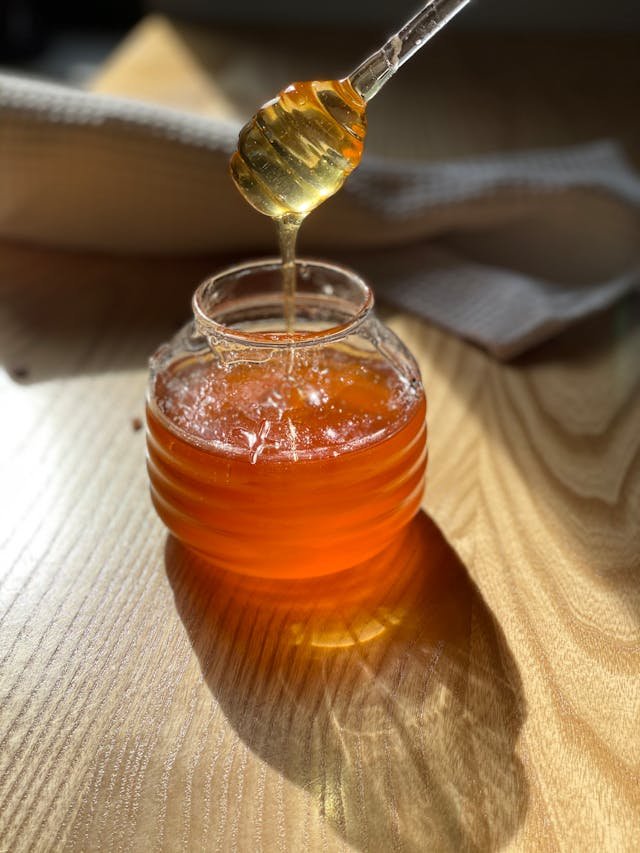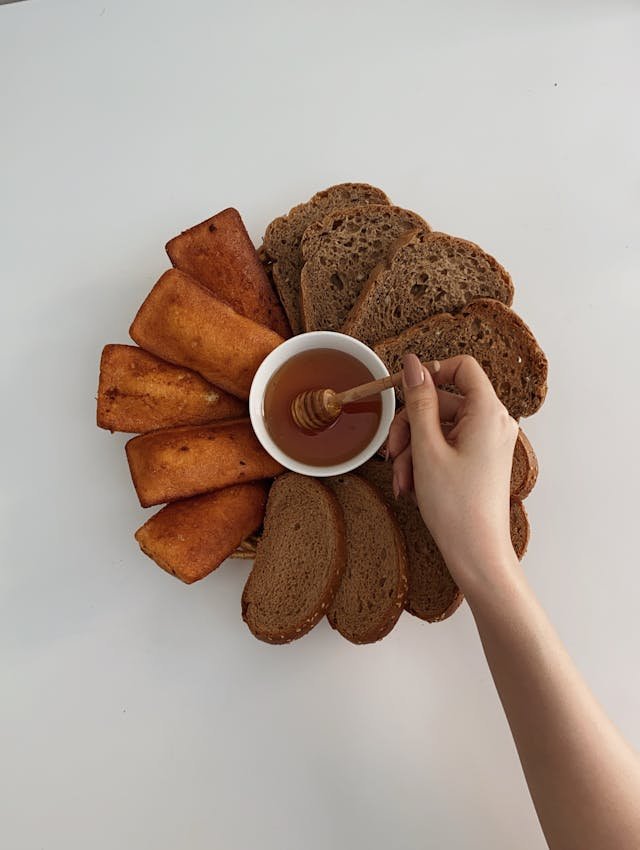African Wildflower Honey is a natural sweetener. It’s healthy and full of vitamins and antioxidants. It helps boost your immunity and improve digestion. This honey comes from Africa’s wildflowers and has a unique, rich flavor. It’s great for your skin and can be used in many recipes. Choose African Wildflower Honey for a pure, ethical, and tasty option.
What is African Wildflower Honey?
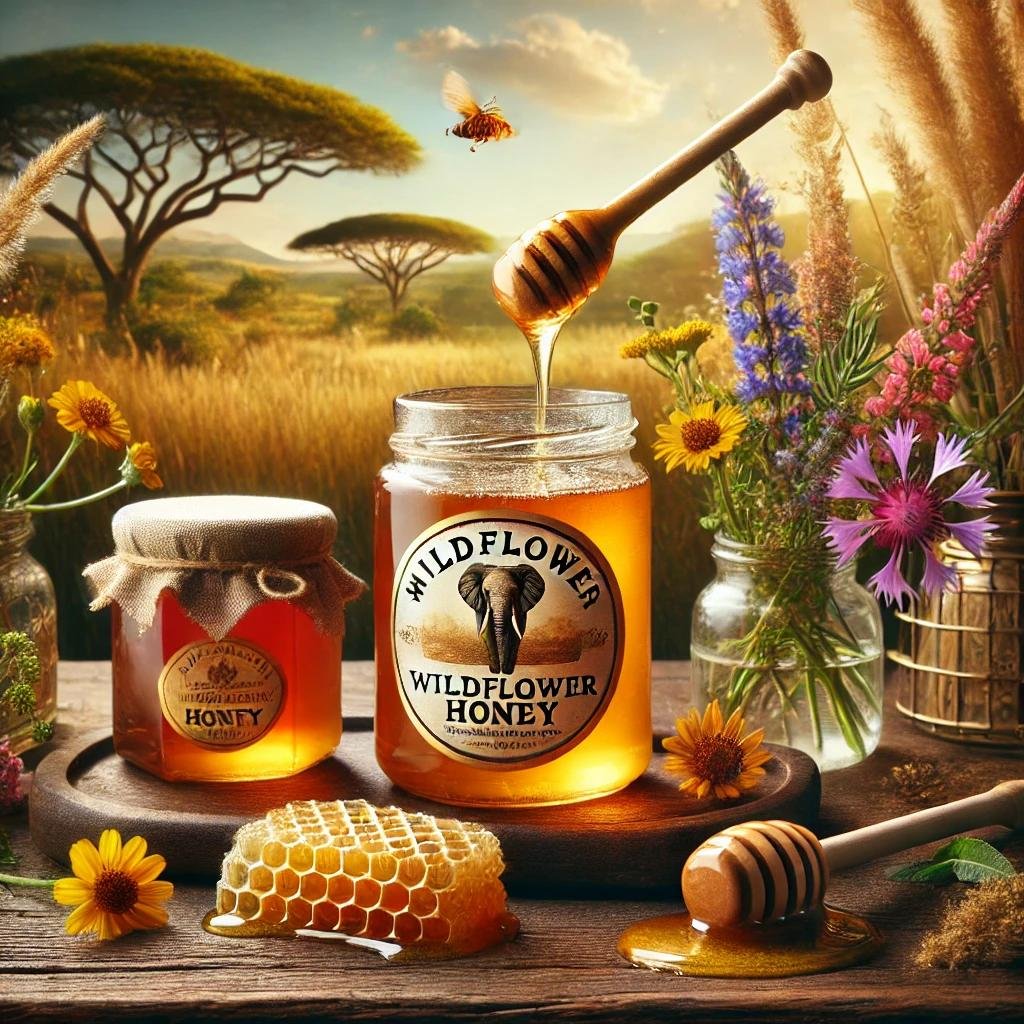
African wildflower honey is unique. It comes from bees that collect nectar from wildflowers in Africa. This honey is different from regular honey. Regular honey comes from farm-grown flowers. In contrast, this honey comes from wild plants. The bees visit different flowers, so the taste of this honey is unique. It can vary from place to place.
This honey is known for its sweet and floral taste with some earthy flavors. People love it for its health benefits. It helps boost your immune system and gives you energy.
Key Takeaways
- African wildflower honey is made by bees that visit wild, natural plants.
- It has a sweet, floral taste and can taste a little earthy.
- It has health benefits and can help with things like immunity.
Health Benefits of Wildflower Honey

Wildflower honey is more than a sweet treat. It offers various health benefits that boost overall wellness. The mix of antioxidants, enzymes, and antibacterial qualities makes it a popular choice for health issues. Here are some great health benefits of wildflower honey. You’ll also find tips to add it to your daily routine and real user opinions on its effectiveness.
Rich in Antioxidants
One of the most notable benefits of wildflower honey is its high antioxidant content. Antioxidants protect your body from oxidative stress. This stress can cause cell damage and lead to chronic issues. These include heart disease, cancer, and premature aging. Wildflower honey is rich in phenolic compounds and flavonoids. These antioxidants help protect against harmful free radicals.
Tip:
- Add 1–2 teaspoons of wildflower honey to your morning tea or smoothie. It gives a natural boost of antioxidants.
- Replace refined sugars in recipes with it. It keeps beneficial nutrients and adds sweetness.
Key Benefits:
- Shields cells from oxidative stress. This helps lower the risk of chronic diseases, such as cancer and heart disease.
- Supports skin health and slows signs of aging by fighting free radicals.
- Boosts immunity by protecting cells from damage. Sources: organicfacts.net, livestrong.com.
Public Opinion: Many people say that eating wildflower honey every day helps them feel more energetic and healthy. “I started adding wildflower honey to my morning tea. “I feel more energized and less tired during the day,” says Sarah, a health-conscious shopper. Several reviews mention that antioxidants enhance skin clarity. Users have noticed a drop in acne breakouts.
Boosts Immunity and Digestive Health
Wildflower honey has natural enzymes and antibacterial traits. These qualities help boost your immune system and support healthy digestion. Honey contains enzymes that help digest food. This improves how well our bodies absorb nutrients. It is particularly helpful for soothing digestive issues like constipation, bloating, and indigestion.
Tip:
- Take 1 tablespoon of wildflower honey each morning on an empty stomach. This helps with digestion and supports gut health.
- For relief from digestive discomfort, mix honey with warm water and sip it before meals.
Key Benefits:
- Helps to balance the gut microbiome, promoting good digestion.
- Soothes the stomach lining and can help with acid reflux and bloating.
- Strengthens the immune system by supporting healthy gut flora. teamboma.com.
Public Opinion: Consumers often mention how wildflower honey has helped with digestive problems. Mark, a user from an online wellness forum, says, “I’ve used honey for my gut health for months. It really helps with bloating.” Many people say it helps with heartburn. They report big improvements in digestion after using it regularly.
Antibacterial and Antiviral Properties
Wildflower honey has natural antibacterial and antiviral properties. This is one of its main benefits. The honey’s antimicrobial effects help combat harmful bacteria, viruses, and fungi. This makes it an excellent remedy for colds, coughs, sore throats, and skin infections. Honey can work as well as some over-the-counter treatments for certain conditions.
Tip:
- For a sore throat, mix 1 tablespoon of wildflower honey with warm water or herbal tea. This soothing drink will help relieve throat irritation and fight off bacteria.
- Use wildflower honey on minor cuts or burns. It helps heal and lowers the risk of infection.
Key Benefits:
- Fights off bacterial and viral infections. This makes it helpful for colds, coughs, and sore throats.
- Works as a natural antibiotic, speeding up recovery from wounds and infections.
- It can prevent and treat acne due to its antimicrobial properties.
Public Opinion: Lots of people like wildflower honey. They say it helps with colds and flu symptoms. “Whenever I feel a cold coming on, I mix honey with ginger and lemon. It soothes my throat and reduces my symptoms quickly,” says Anne, a regular user. Parents love honey for treating their kids’ coughs. They say it’s natural and gentle, unlike chemical options.
Honey for Skin Health and Beauty
Wildflower honey is an excellent ingredient for skincare. It’s full of moisturizing and healing benefits. It nourishes skin, fights acne, and slows aging signs. Honey helps keep your skin clear and reduces the risk of infections. It also acts as a humectant, meaning it draws moisture from the air into the skin, leaving it hydrated and soft.
Tip:
- Use wildflower honey as a face mask. Spread a thin layer on your face. Let it sit for 10–15 minutes. Rinse it off with warm water for a natural glow.
- To make a DIY exfoliating scrub, mix wildflower honey with sugar or oatmeal. Then, gently massage it onto your face or body.
- Add wildflower honey to your bath for a moisturizing, relaxing experience.
Key Benefits:
- Moisturizes and hydrates the skin, leaving it soft and smooth.
- Helps to reduce acne and prevent future breakouts.
- Fights wrinkles and fine lines by promoting skin elasticity teamboma.com
Public Opinion: Consumers are particularly excited about the skin benefits of wildflower honey. “My skin has never felt smoother! After using it as a face mask for a few weeks, I noticed fewer pimples and softer skin,” says Laura, a beauty enthusiast. Many skincare experts suggest using honey instead of harsh chemicals. Many users praise its ability to give a healthy glow without causing irritation.
Additional Tips for Maximizing the Benefits of Wildflower Honey
- Use in Tea or Coffee: Try wildflower honey instead of sugar in your hot drinks. It offers health benefits and a delicious, natural sweetness.
- Add a spoonful of honey to your smoothies. It gives an energy boost and adds sweetness.
- Honey and Lemon for Colds: Mix wildflower honey and lemon juice in warm water. This can help soothe colds, coughs, and sore throats.
- DIY Skincare: Make your own face masks, lip balms, or body scrubs. Use wildflower honey for soft, glowing skin.
Adding wildflower honey to your daily routine offers many health benefits. It can boost your immunity, improve digestion, and enhance skin health. It’s a natural product. It tastes great and supports overall wellness. Many people support its effectiveness. They report big improvements in health and beauty from regular use.
Floral Sources and Flavor Profile of Wildflower Honey
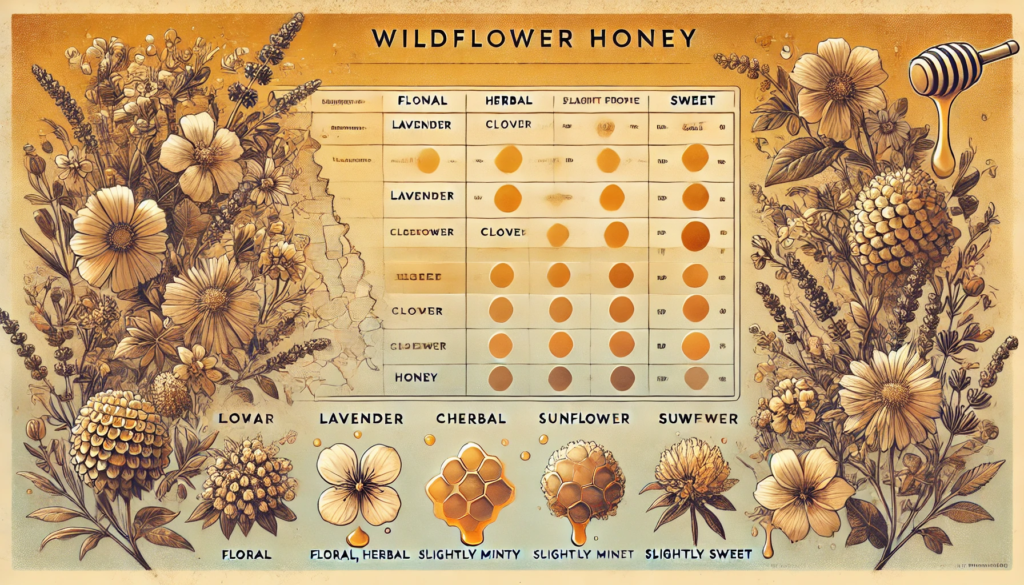
The flowers in African wildflower honey are key to its flavor and texture. Bees gather nectar from many flowers. Each flower type adds a special flavor to the honey. The honey’s flavor is also shaped by the region where it is made. Let’s look at how flowers like tropical varieties, eucalyptus, and acacia affect the taste and feel of honey.
Tropical Flowers: Sweet and Fruity Notes
In tropical regions of Africa, bees often gather nectar from flowers like mango, guava, and papaya. Honey made from these flowers is usually sweet, with a fruity, tropical flavor. This type of honey is often light in color, and it tends to be smooth and liquid in texture. Tropical wildflower honey is great for anyone who likes a mild, sweet flavor. It’s sweet but not too strong.
- Taste: Sweet, fruity, tropical.
- Texture: Liquid and smooth.
Eucalyptus: Fresh, Menthol-Like Flavor
Eucalyptus trees grow in many areas of Africa. The nectar from their flowers adds a stronger and more unique flavor to honey. Eucalyptus wildflower honey has a cool taste, much like menthol. It’s dark amber in color and often has a rich, earthy flavor with a slight herbal or medicinal note. This honey is great for those who like bold flavors with a touch of freshness.
- Taste: Strong, herbal, menthol-like.
- Texture: Thick and viscous.
Acacia: Light, Delicate, and Floral
Acacia flowers are a top source of wildflower honey in Africa. Acacia wildflower honey offers a soft and mild flavor. It offers a sweet, floral taste that isn’t overpowering. This honey is often pale in color and has a smooth, runny texture. Many people who like a milder, lighter honey enjoy acacia honey. It’s perfect for adding to tea or drizzling over toast or yogurt.
- Taste: Light, floral, mildly sweet.
- Texture: Smooth and runny.
How Regional Flora Affects Flavor
Regional flowers affect the honey’s flavor. For example:
- In dense tropical forests, honey usually tastes fruity. This flavor comes from flowers like mango and guava.
- In dry climates or savannas, honey can come from baobab plants. This type of honey has a stronger, tangier flavor and an earthy undertone.
- Eucalyptus trees grow in some areas and make honey. This honey has a cool, minty flavor. It’s quite different from the sweet taste of tropical flowers.
The climate and local plants shape the flavor and texture of honey. African wildflower honey is a special treat.
Final Thoughts
African wildflower honey is unique because of its floral sources. Bees visit flowers like mango and guava, eucalyptus, and acacia. These flowers offer a mix of tropical sweetness, herbal depth, and gentle floral hints. This is what makes each batch taste unique. Regional plants and climate mix to create many flavors. Each jar of wildflower honey shows Africa’s natural beauty and variety.
Key Takeaways
- Tropical flowers give honey a sweet, fruity flavor and liquid texture.
- Eucalyptus provides a cool, menthol-like taste and a thicker texture.
- Acacia flowers create light, floral honey with a smooth, runny texture.
How Wildflower Honey is Harvested: Beekeeping Practices and Sustainability
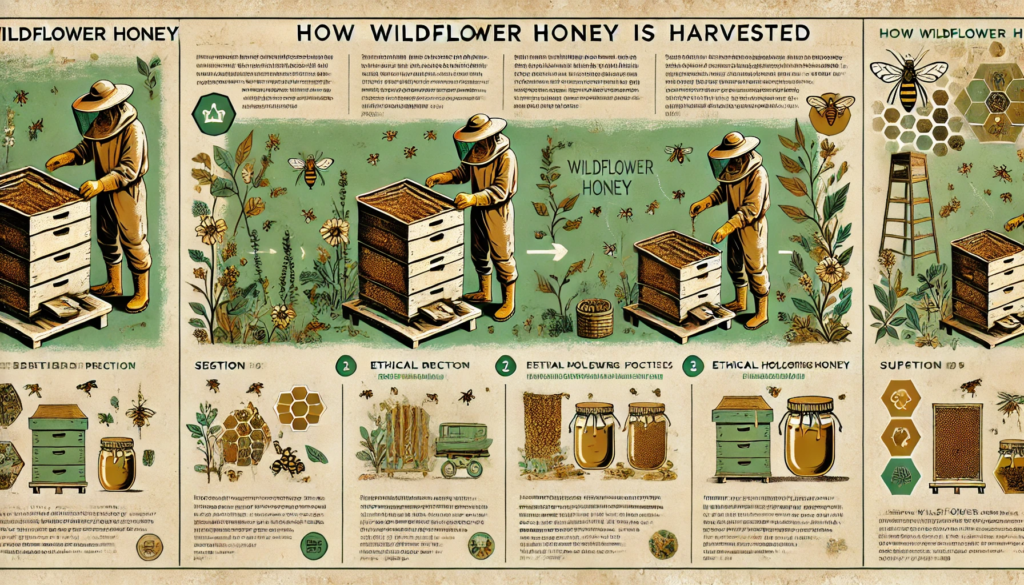
Harvesting wildflower honey combines the art of beekeeping with eco-conscious methods. It reflects a deep love for nature. Here’s how the process works:
First: Setting Up the Beehive
To harvest wildflower honey, beehives are arranged in fields full of wildflowers. Beekeepers usually pick spots close to forests, meadows, or open fields. These areas have many flowers for bees to visit. These hives are usually set up in quiet spots. This lets the bees work naturally without being disturbed.
- Beekeeping Tip: Choose a location with diverse plants and no pesticides to keep your bees healthy.
Second: Bee Colony Care
Beekeepers keep a close eye on their bee colonies all year round. This means making sure the bees have enough food. It also means checking for diseases and making sure the hive is strong and productive. Some beekeepers give bees extra food in tough seasons. This helps keep them healthy.
- Beekeeping Tip: A healthy colony is key for a good harvest. Healthy bees gather nectar more efficiently.
Third: Flower Pollination and Nectar Gathering
Once the bees are in place, they begin to collect nectar from a wide range of wildflowers. These consist of tropical flowers, acacia, eucalyptus, and others. It all depends on the region. Bees collect nectar from flowers. Then, they return to the hive. There, they transform it into honey. They add enzymes and dry the nectar by fanning it.
Fourth: Harvesting the Honey
After the bees have produced enough honey and stored it in the honeycomb, beekeepers know it’s time to harvest. The honeycomb is carefully removed from the hive, and the wax caps that seal the honey are gently removed. The honey is then extracted through a centrifuge that spins the honey out of the combs without harming the bees.
- Beekeeping Tip: Beekeepers take only extra honey. This way, bees have enough to survive winter.
Fifth: Ethical Harvesting Practices
One of the key aspects of wildflower honey harvesting is ethical practices. Ethical beekeeping means beekeepers don’t take all the honey from the hive, leaving enough for the bees to feed on. It also uses organic methods to care for the bees. This way, the environment stays safe from harmful chemicals and pesticides. Some beekeepers use sustainable methods. They rotate hive locations. This helps avoid over-harvesting in one area.
- Sustainability Tip: Practice ethical beekeeping. It keeps bees healthy and benefits the local environment. This ensures honey production stays sustainable for the long run.
Sixth: Community Involvement and Fair Trade
In many parts of Africa, wildflower honey harvesting is a community effort. Beekeepers often team up. They share knowledge and resources. This helps support sustainable honey production. Local communities can join in the harvest. They help gather honey, process it, and sell it. This ensures fair pay for workers and supports local economies.
- Community Tip: In many areas of Africa, local communities gain from honey harvesting. It creates jobs and encourages ethical trade practices.
Seventh: Packaging and Distribution
After extraction, the honey is filtered to remove any impurities and is packaged for sale. It’s important that honey is handled carefully to keep its natural properties intact. Many beekeepers and honey producers use green packaging. This cuts down on environmental harm and keeps the process sustainable.
- Sustainability Tip: Choose containers for honey that you can recycle or that break down naturally. This keeps the process green.
Harvesting wildflower honey is a careful process. It blends traditional beekeeping with sustainable practices. Beekeepers care about bee health. They practice ethical harvesting and engage with the community. This way, they ensure the honey is high quality and good for the environment and local communities.
Key Takeaways
- Beekeepers put hives near various wildflowers. This lets bees forage naturally.
- Ethical harvesting leaves enough honey for the bees. This supports sustainability.
- Community involvement plays a key role in supporting fair trade and local economies
Nutritional Value of Wildflower Honey: What Makes Wildflower Honey Nutrient-Rich?
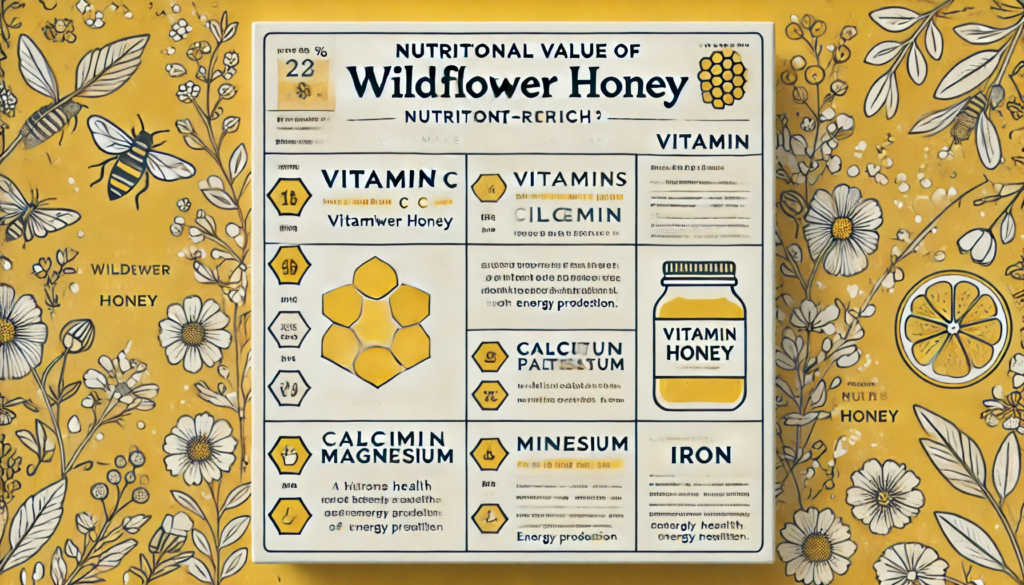
Wildflower honey is more than just a sweet treat. It contains many nutrients that offer health benefits. It’s a natural source of vitamins, minerals, and other key compounds. These support your overall health. Here’s a breakdown of what makes this honey nutrient-rich and beneficial for your body.
Vitamins and Minerals
Wildflower honey has important vitamins and minerals. They help your body work well. These include:
- Vitamin C: This vitamin boosts the immune system. It protects cells from damage and helps wounds heal.
- B Vitamins: Wildflower honey is rich in B1 (Thiamine), B2 (Riboflavin), B3 (Niacin), and B5 (Pantothenic Acid). These vitamins are key for energy production, nerve function, and healthy skin.
- Minerals: Wildflower honey has small amounts of key minerals such as calcium, magnesium, iron, and zinc. These minerals are vital for bone health, muscle function, and supporting the immune system.
Natural Sugars
Wildflower honey mainly gets its energy from natural sugars, such as fructose and glucose. These sugars provide a quick energy boost and are easily absorbed by the body. Honey has natural sugars. It also has useful compounds, such as antioxidants and enzymes. This makes honey a healthier choice than processed sugars.
- Fructose: This sugar enters the bloodstream slowly. It gives a steadier energy release.
- Glucose: Quickly absorbed by the body, offering an immediate energy boost.
Antioxidants
Wildflower honey is full of antioxidants. These include phenolic compounds, flavonoids, and carotenoids. These compounds reduce oxidative stress. They do this by neutralizing free radicals. Free radicals are harmful molecules. They can damage cells and lead to chronic diseases, such as cancer, heart disease, and aging.
A study in the Journal of Agricultural and Food Chemistry found that darker honey, like wildflower honey, has more antioxidants than lighter honey. This means that darker wildflower honey can offer even greater health benefits due to its higher antioxidant content.
Enzymes and Amino Acids
Wildflower honey includes vitamins, minerals, and antioxidants. It also has enzymes and amino acids. These enzymes are naturally present in honey and help break down the nectar the bees collect. Invertase and diastase help digest sugars. Amino acids are the building blocks of proteins. They also support important body functions.
Amino acids, including proline and glutamine, play a key role in muscle repair. They also support immune function and help produce energy. This makes wildflower honey a great addition to an active lifestyle or a post-workout snack.
Water and Other Compounds
Though honey is not particularly high in water, it still contains a small amount of water (about 17–20%). This helps make it easily digestible and contributes to its smooth texture. Wildflower honey also has organic acids, such as gluconic acid. This helps preserve it and gives it a subtle tangy taste.
Wildflower honey is rich in nutrients. It offers vitamins, minerals, and helpful compounds. These include antioxidants, enzymes, and amino acids. These nutrients help the body in many ways. They boost the immune system and provide quick energy. Wildflower honey is great as a sweetener, energy boost, or natural remedy. It also provides health benefits that go beyond its flavor.
Key Takeaways
- Wildflower honey is rich in vitamins like C, B1, B2, B3, and B5. It also contains minerals such as calcium, magnesium, iron, and zinc. Plus, it has antioxidants.
- Natural sugars, such as fructose and glucose, give fast and lasting energy.
- Amino acids and enzymes in wildflower honey help with digestion and muscle recovery.
References:
- Journal of Agricultural and Food Chemistry. (2014). Antioxidant Activity of Honey.
National Honey Board. (2020). Nutritional Composition of Honey.
Uses of Wildflower Honey: Culinary and Medicinal Applications
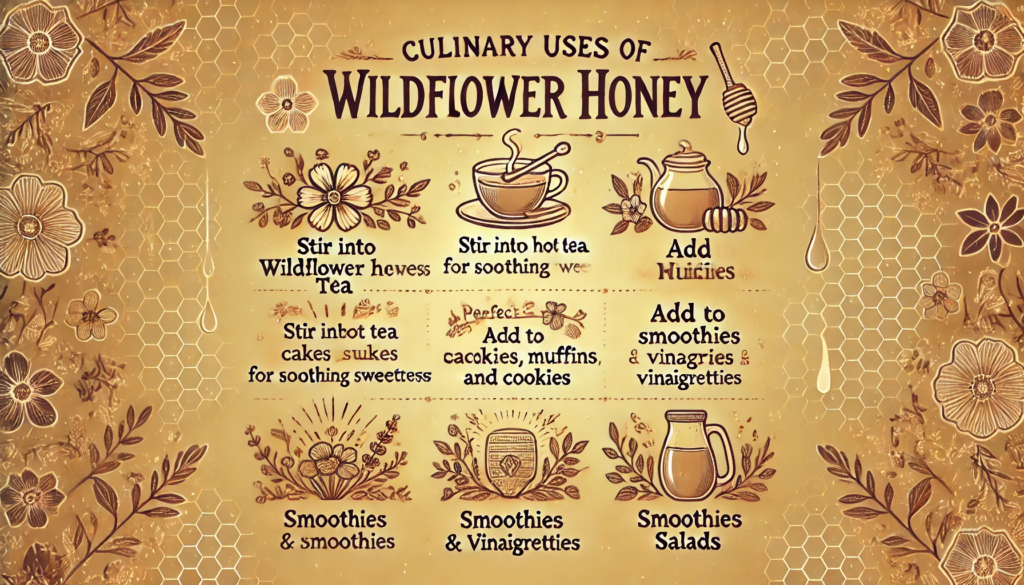
Wildflower honey is not just a sweet treat—it’s also a powerhouse with a wide range of culinary and medicinal uses. Whether you’re using it to enhance a recipe or improve your health, this honey has something for everyone. Next, we’ll look at its cooking and health benefits. We’ll share real-life examples to show how versatile it can be.
Culinary Uses: Sweetening and Flavoring Dishes
Wildflower honey is a natural sweetener that can enhance both savory and sweet dishes. Here are some common ways people incorporate it into their cooking:
- In Tea and Beverages: Wildflower honey is a classic addition to tea, whether it’s black, green, or herbal. The floral sweetness goes well with the earthy taste of tea. This makes it a popular choice for people who want to reduce processed sugars. Many people also add it to lemonade or smoothies for an extra burst of natural sweetness.
- Real-life example: A popular drink in Africa is ginger tea, where wildflower honey is added to soothe sore throats. It’s a favorite among locals, especially during the colder months.
- In Baking: Wildflower honey is a key ingredient in many baked goods, including cakes, muffins, and cookies. It provides moisture and adds a rich flavor that can’t be achieved with regular sugar. It’s often used in recipes for banana bread or honey cakes, giving them a deep, caramel-like sweetness.
- Honey cake is a traditional dessert in many African countries. It uses wildflower honey for a rich, sweet flavor. It’s usually served at celebrations. It represents prosperity and sweetness for the new year.
- In Dressings and Sauces: Add wildflower honey to salad dressings, marinades, and barbecue sauces. It gives a sweet touch. Its natural sweetness balances the acidity in vinegar or lemon juice. When mixed with mustard and herbs, it makes a great dressing for salads or a glaze for grilled meats.
- A popular dish in Southern Africa features grilled chicken. It’s topped with a wildflower honey and mustard glaze. This glaze adds a tangy sweetness that makes the meat taste even better.
- In Spreads and Jams: You can mix wildflower honey with peanut butter, almond butter, or cream cheese for tasty spreads. These can be enjoyed on toast or used in sandwiches and wraps.
- In many African homes, people often spread honey and butter on bread or scones. This is especially popular at breakfast.
Medicinal Uses: Natural Remedies for Health
Wildflower honey is great for cooking. It has also been used in traditional medicine for centuries. Its healing effects arise from its natural antibacterial, antiviral, and anti-inflammatory properties. Here are some medicinal uses:
- Soothing Cough and Sore Throat: One of the most common uses of wildflower honey is for soothing sore throats and coughs. Honey helps fight infections because it has natural antibacterial properties. Its thick texture coats the throat, which helps reduce irritation.
- In many African cultures, people drink a warm mix of wildflower honey, ginger, and lemon. This helps relieve coughs and soothes sore throats. This remedy is especially popular during flu season or after a cold.
- Healing Wounds: Wildflower honey has antibacterial properties. This makes it helpful for treating minor cuts, burns, and abrasions. When applied to wounds, it promotes healing and helps prevent infections.
- Real-life example: In rural areas, beekeepers use raw wildflower honey for healing. It can dress wounds and treat skin issues like eczema and burns. Its natural healing power makes it a popular choice.
- Digestive Health: Wildflower honey acts as a natural prebiotic. This means it helps good bacteria grow in your gut. Eating it often can boost digestion and ease constipation.
- Many people mix a spoonful of wildflower honey with warm water and lemon in the morning. This drink helps promote a healthy digestive system. This is a common practice in many African communities to maintain overall gut health.
- Skin Care: Wildflower honey is a natural humectant. It helps keep moisture, so it’s popular in DIY beauty treatments. You can use it directly on your skin as a moisturizing mask or lip balm. You can also mix it with natural ingredients like cinnamon or olive oil for extra benefits.
- Real-life example: African women often use honey in beauty treatments. For example, a wildflower honey and lemon mask is a popular remedy for achieving smooth, glowing skin.
- Boosting Immunity: Wildflower honey is full of antioxidants, vitamins, and minerals. Eating it regularly can strengthen your immune system. This helps protect you from colds and flu.
- Many folks in Africa use wildflower honey every day. They do this to boost their immunity, especially where malaria and other diseases are common. It’s often combined with ginger and turmeric for an even stronger immune-boosting effect.
Wildflower Honey in Cultural Practices
Wildflower honey holds a special place in African traditions and rituals. It is often offered as a gift or used in ceremonies to symbolize health and prosperity.
- In Kenya, people use wildflower honey in traditional healing rituals. It is often mixed with herbs and given to people who are recovering from illness, as it is believed to restore balance and vitality.
Key Takeaways:
- Culinary Uses: You can add wildflower honey to teas, desserts, baked goods, and salad dressings. It brings natural sweetness and flavor.
- Medicinal Uses: It calms coughs, repairs wounds, aids in digestion, and boosts immunity.
- Real-life Example: In Africa, people use wildflower honey for health and in traditional ceremonies. This shows its cultural importance.
This section shows the versatility of wildflower honey in both everyday cooking and healthcare. From adding flavor to recipes to providing natural remedies, it’s clear that wildflower honey is much more than just a sweetener.
Sustainability and Ethical Sourcing: Supporting Sustainable Beekeeping
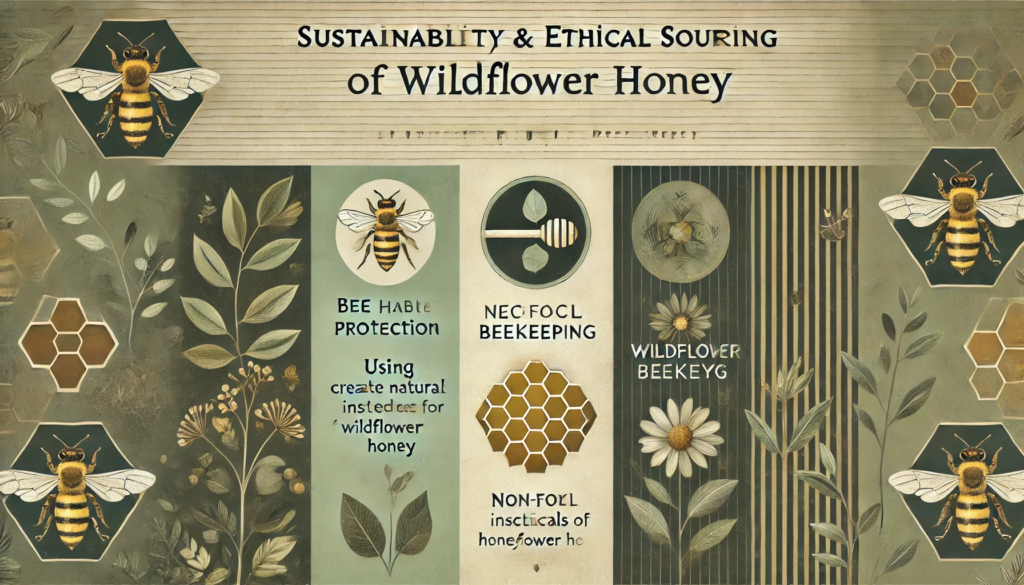
Wildflower honey is good for your health. It can also support sustainable farming and green practices. Consumer awareness of environmental issues is growing. Now, ethical sourcing and sustainability in beekeeping matter more than ever. Supporting local beekeepers helps promote sustainable honey production. This way, we ensure honey is made responsibly. It also benefits the environment and the communities that produce it.
The Importance of Sustainable Beekeeping
Sustainable beekeeping means using methods that help bee health. It also protects the environment. This way, honey production won’t harm the ecosystem. Sustainable beekeepers focus on their bees’ well-being. They care for the land and aim for long-term business success.
Key Practices in Sustainable Beekeeping:
- Bees play a key role in pollinating many plants, not just those that produce honey. Sustainable beekeeping means making sure bees can find plenty of wildflowers and native plants. These plants support the health and productivity of bees.
- No Harmful Pesticides: Ethical beekeepers do not use harmful pesticides or chemicals. These substances can hurt bees and their surroundings. Using organic or non-toxic methods helps save bees and local plants.
- Bee Habitat Preservation: Sustainable beekeepers work to protect bee habitats. They focus on keeping wildflower meadows and natural areas healthy. This is important not just for honey but also for the well-being of bees.
In East Africa, beekeepers use green methods. They keep hives in biodiverse areas. This helps bees pollinate many types of plants. This method helps the local ecosystem and honey production. It’s also better for the environment.
Ethical Honey Production: Fair Practices for Both Bees and People
Ethical honey production cares for the environment. It also means treating bees and workers well. Ethical practices make sure honey is made with respect for the animals and people involved.
Ethical Honey Production Includes:
- No Bee Harm: Ethical beekeepers use kind ways to collect honey. This means reducing stress on bees. It helps them keep a healthy population. Beekeepers use methods to harvest honey sustainably. This way, bees can thrive even after honey collection.
- Fair Worker Treatment: Ethical beekeepers treat their workers well. They pay fair wages and ensure safe working conditions. Support local beekeepers to promote fair trade.
In South Africa, local beekeepers use ethical methods. They harvest honey with care. They let the bees work without harm. These ethical producers take care of their bees. They support the local economy and help the ecosystem.
Supporting Local Beekeepers: The Impact on Communities
Consumers who opt for honey that’s sustainably and ethically sourced enjoy a great product. They also help local communities and boost the economy for beekeepers.
How Supporting Local Beekeepers Helps:
- Economic Stability for Local Farmers: Many beekeepers in Africa are small farmers. They depend on honey production to make a living. When consumers back local beekeepers, they assist these farmers. This support lets beekeepers offer great honey. It also helps them support their families and communities.
- Support Local Traditions: Get honey from local beekeepers to help keep their traditions alive. These practices are usually more sustainable. They fit the local area and help keep the region’s culture alive.
- Conservation Efforts: Beekeepers team up with conservation groups. They help protect biodiversity and natural habitats. When consumers back beekeepers, they boost conservation efforts. This action ensures that pollinators and other wildlife can survive.
Real-life Example: In Kenya, some groups work on community beekeeping. They use sustainable methods. This work helps local farmers gain a steady income. These small projects have boosted the finances of local families. They help protect Kenya’s native forests. They aim for sustainable beekeeping and make honey responsibly.
How Consumers Can Contribute to Sustainable Honey Production
Consumers are vital in helping to produce honey in a sustainable and ethical way. Here are some simple actions that make a significant difference:
- Choose Organic Honey: Look for honey that says certified organic or fair trade. These labels mean the honey is made using eco-friendly and ethical methods.
- Buy Honey Locally: Support local beekeepers. They use ethical and sustainable methods. Choose local whenever you can. This supports the community. It also ensures the honey you eat is made responsibly.
- Explore the effects of honey production on the environment. Then, share what you discover with others. Consumers care about sustainability. They look for products made ethically.
Key Takeaways
- Sustainable beekeeping helps bees and the environment thrive. It also supports long-term honey production.
- Ethical Honey production cares for bees and workers. It ensures bees are treated well and workers have fair conditions.
- When you support local beekeepers, you help keep traditions alive. This also strengthens local businesses and benefits conservation.
Picking sustainably made wildflower honey gives you a sweet and healthy snack. It also supports ethical and eco-friendly practices. It’s good for the planet, boosts local communities, and supports those in the future. By supporting local beekeepers and sustainable honey, we can create a fairer and greener future.
Where to Buy Wildflower Honey: Finding Quality Honey
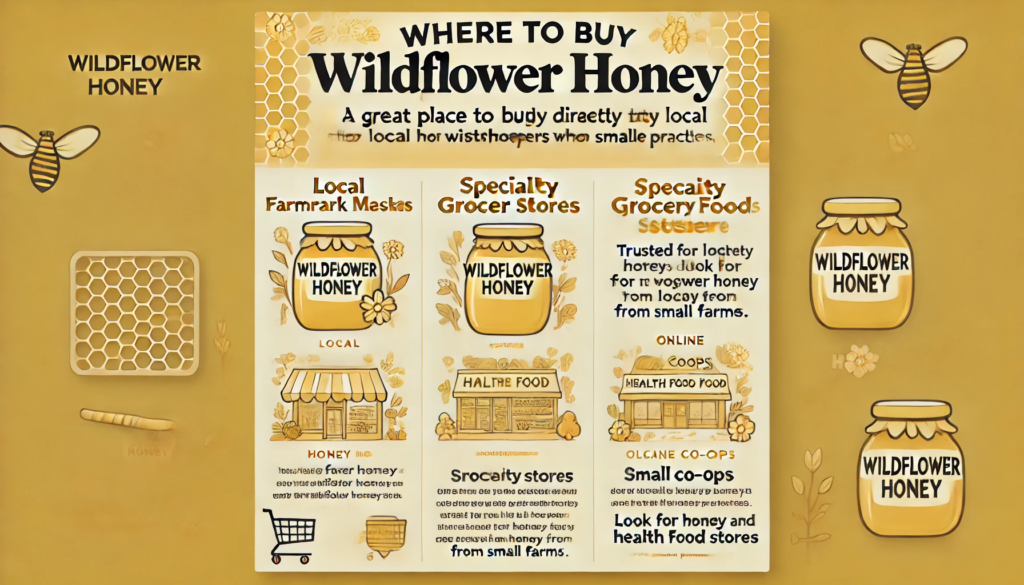
Wildflower honey can be found at a variety of places, both online and offline. The most common sources include:
Local Farmers’ Markets
Local farmers’ markets are a great place to find raw and unprocessed wildflower honey. Many small beekeepers sell their honey directly to customers at these markets. This way, the honey stays fresh and high-quality. Buying at a farmer’s market supports local businesses. It also promotes sustainable practices.
- Why buy from farmers’ markets? You can talk directly to the beekeeper, ask questions about the honey’s source, and even try samples before making a purchase.
- Health Food Stores
Health food stores or organic shops often sell good wildflower honey. These stores usually sell natural and organic products. They often have honey that is pure and unfiltered, free from additives.
- Tip: Look for honey labeled as raw, unprocessed, or organic to ensure it retains all its natural benefits.
Online Retailers
Buying wildflower honey online gives you access to a wide variety of options from different regions. You can find many types of wildflower honey on sites like Amazon and Etsy. Specific sellers like Beehive Honey and HoneyWorld also offer great options. You can find both local and international options.
- Why buy online? Online stores offer a big selection. They have detailed product descriptions, customer reviews, and the ease of home delivery.
Specialty Stores
Some stores sell premium wildflower honey. This is common in gourmet food and artisan shops. These stores often sell honey from specific flowers or regions. For example, you can find African wildflower honey here, which is hard to find in other places.
- Tip: Ask store staff for details about the honey’s origin and production methods to ensure quality.
- Direct from Beekeepers
If you’re looking for the freshest possible honey, buying directly from beekeepers is the best option. Many local beekeepers have websites or social media pages where you can buy their honey. When you buy directly, you can discover how the honey is made sustainably and ethically.
- Example: Some African beekeepers sell their honey online. You can try wildflower honey from places like Kenya or Tanzania. This option often offers the most authentic and high-quality honey, straight from the hive.
How to Identify Quality Wildflower Honey
When buying wildflower honey, know what to look for. This helps you get pure, unprocessed, and authentic honey. Here are some key things to check:
Labeling: Raw and Unfiltered Honey
Look for honey labeled as raw or unfiltered. These terms mean the honey hasn’t been heated or pasteurized. Heating can remove its natural nutrients and flavor. Raw honey has more enzymes, antioxidants, and vitamins than processed honey.
- Tip: If the label doesn’t say raw or unfiltered, chances are it has been pasteurized, which can reduce its health benefits.
Color and Consistency
Wildflower honey can be light amber or dark amber. The color depends on the flowers the bees visit. The texture can also vary, from liquid to creamy. It’s natural for honey to crystalize over time; this doesn’t mean it’s gone bad.
- Tip: If the honey is overly runny or has a watered-down texture, it might be diluted or fake. Pure honey should be thick and smooth.
Aroma and Taste
Fresh wildflower honey should have a pleasant floral aroma and a natural, rich sweetness. The flavor can change based on the flower used. It should taste natural and pure, with no chemical aftertaste or fake sweetness.
- Tip: If the honey tastes or smells artificial, it probably has corn syrup or other additives.
Honey Source and Certification
If you want high-quality honey, look for certifications. Check for labels like organic, fair trade, or local sourcing. These certifications guarantee that the honey has been produced in an ethical and sustainable way.
- Tip: Look for certifications from trusted groups, such as Fair Trade or USDA Organic. These add credibility.
Pricing: How Much Should Wildflower Honey Cost?
Wildflower honey prices can change based on several factors. These include where it comes from, how it’s made, and how available it is in the market. Here’s a general breakdown of what to expect in terms of pricing:
Price Range
- Local and Raw Honey: Expect to pay between $10 to $30 per jar for high-quality, local, raw wildflower honey. Smaller jars (8 oz) might cost less, while larger jars (16 oz or more) can be more expensive.
- Imported Honey: Specialty honey, such as African wildflower honey, usually has a higher price. This is due to shipping fees and its unique appeal. Prices for these types of honey can range from $20 to $50 or more per jar.
- Bulk Purchases: Many online stores offer discounts for buying in bulk. You can buy larger amounts, like a gallon or a 5-gallon drum, at a lower cost. Prices range from $60 to $150, based on quality.
What Affects Pricing?
- Organic Certification: Organic wildflower honey usually costs more. This is because organic farming is expensive.
- Sourcing Location: Honey from rare spots, like African wildflower honey, tends to cost more. This is due to higher shipping costs and its limited availability.
- Small-Scale vs. Mass-Produced Honey: Honey from small-scale beekeepers is often more expensive. They use ethical and sustainable methods. In contrast, mass-produced honey may be diluted or heavily processed.
Value for Money
Wildflower honey may cost more than mass-produced honey. However, its purity, taste, and health benefits often make it a worthwhile choice. Also, when you buy from sustainable sources, you support ethical beekeeping. This helps the bees thrive.
Key Takeaways:
- Where to Buy: You can get quality wildflower honey at local farmers’ markets, health food stores, online, and from beekeepers.
- How to Identify Quality:
- Look for raw, unfiltered honey.
- Check the color and consistency.
- Taste the flavor.
- Verify sourcing and certifications.
- Pricing: Prices vary from $10 to $50 per jar. It depends on the honey’s quality and origin. Organic or imported varieties may be more expensive.
By using these tips, you can pick the best wildflower honey. It will taste great and support sustainable, ethical practices.
Wildflower Honey vs. Other Types of Honey
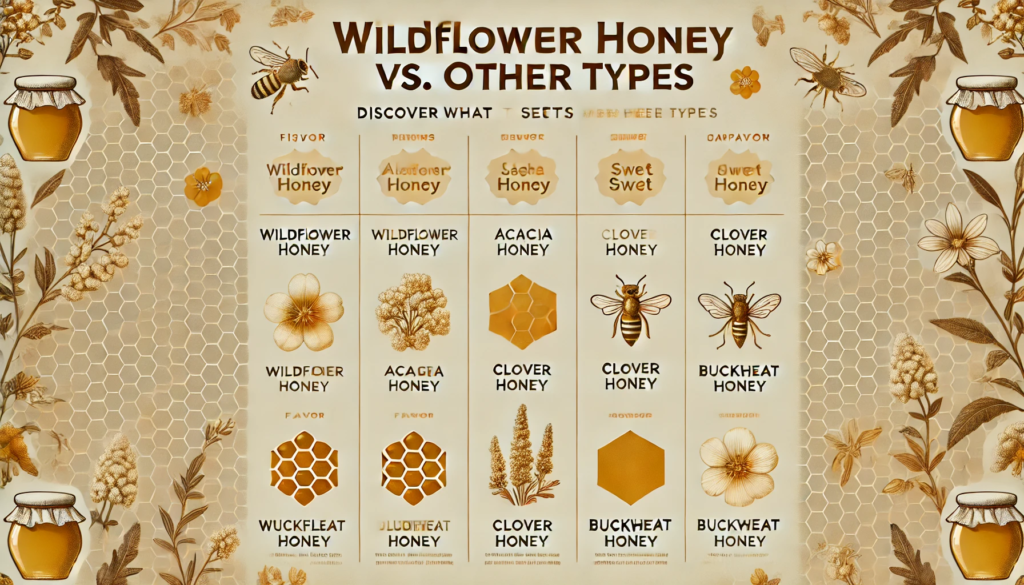
Here’s a table comparing Wildflower Honey with other popular types of honey, focusing on their unique benefits and distinctions:
Honey Type | Wildflower Honey | Acacia Honey | Manuka Honey | Clover Honey |
Floral Source | Collected from various wildflowers | Mainly from the nectar of the Acacia tree | Derived from the Manuka bush in New Zealand and Australia | Collected primarily from clover flowers |
Color | Varies from light amber to dark amber | Light, pale amber or colorless | Dark amber to reddish-brown | Light amber, often clear or pale yellow |
Flavor Profile | Floral, sweet, earthy, with hints of different flowers | Very mild, light, and slightly sweet | Bold, rich, and earthy with a slight medicinal flavor | Mild, sweet, and neutral with no strong aftertaste |
Texture | Smooth, may crystallize over time | Thin, liquid consistency | Thick, sometimes gel-like, especially raw Manuka honey | Smooth, often liquid, but can crystallize |
Health Benefits | High in antioxidants, antibacterial properties, supports immunity and digestive health | Excellent for soothing sore throats and allergies, rich in fructose for energy | Known for its strong antibacterial and antiviral properties, often used for wound healing | Good for general health and energy, supports digestive health |
Common Uses | Culinary, skin care, natural remedies (cough, sore throat) | Best for soothing throat, in teas, or as a natural sweetener | Medicinal uses: wound care, skin healing, gut health | Culinary, baking, teas, and general consumption |
Price | Generally affordable, varies by region and supplier | Moderately priced, more expensive than regular honey | Expensive due to limited supply and special medicinal properties | Affordable and widely available, often cheaper than other types |
Crystallization | Crystallizes quickly and naturally | Crystallizes slowly, sometimes stays liquid | Crystallizes slowly but retains texture for longer | Crystallizes over time, but less fast than wildflower honey |
Availability | Available in local markets, farmers’ markets, and online | Widely available in stores and online | Rare, usually found in specialty stores or online | Readily available in most grocery stores and supermarkets |
Key Takeaways:
- Wildflower Honey is unique because it comes from many different flowers. It also has great antioxidant properties.
- Acacia Honey is gentle. It helps soothe sore throats. Manuka Honey, on the other hand, is famous for its strong antibacterial effects.
- Clover Honey is a widely accessible and mild honey, perfect for general use.
Knowing the unique traits of each honey type helps consumers pick what they need. They can choose honey for cooking, health benefits, or just for enjoyment.
Why Choose Wildflower Honey?
Wildflower honey stands out for its health benefits, great taste, and sustainable sourcing. Whether you’re looking for a natural sweetener, seeking health benefits, or supporting ethical beekeeping practices, wildflower honey ticks all the boxes. Here’s a summary of why you should consider choosing wildflower honey:
Key Benefits of Wildflower Honey:
Health Benefits:
- Wildflower honey is rich in antioxidants, which help protect the body from damage caused by free radicals.
- It can boost immunity and aid digestive health, making it a great addition to your daily diet.
- Wildflower honey naturally fights bacteria and viruses. It also serves as a remedy for common issues like coughs and sore throats.
Sustainability:
- Choosing ethically sourced wildflower honey supports local beekeepers. This helps keep bee populations healthy for the long term.
- It advocates for sustainable beekeeping. This is crucial for both the environment and biodiversity.
Flavor and Versatility:
- Wildflower honey tastes floral and earthy. Its sweetness changes based on the flowers that bees visit.
- It’s great for teas, desserts, and even skincare. This makes it a useful addition to your home.
Public Opinion:
Lots of wildflower honey fans love its natural taste and health perks. Customers love its smooth texture and rich taste in online reviews. They say it improves both everyday meals and special dishes. Many people with allergies say that local wildflower honey helps with their symptoms. This is because it contains pollen.
Some consumers say the price is higher than regular supermarket honey. However, they often feel the benefits make it worth the cost. They love the product’s freshness and purity. They also feel good knowing they support sustainable beekeeping.
Personal Opinion:
I think wildflower honey is a great addition to my kitchen. The rich flavor enhances simple teas and baked goods. Plus, it offers several health benefits. Supporting local beekeepers feels great. It also helps promote sustainable practices. Plus, you get to enjoy a high-quality, natural product. You can add wildflower honey to your morning tea or use it in DIY skincare. Its versatility and benefits are unmatched.
In conclusion, wildflower honey is more than just a sweet treat. Its health benefits, eco-friendliness, and great taste make it a top choice for those who value quality and ethics.
Frequently Asked Questions (FAQ)
What Makes African Wildflower Honey Unique?
African wildflower honey is special. It comes from the nectar of many wildflowers found in Africa. These are eucalyptus, acacia, and other tropical flowers. This diversity creates a rich flavor profile. It ranges from floral and sweet to earthy and tangy. African wildflower honey is often harvested using traditional and sustainable methods. This makes it a tasty and eco-friendly option.
Is Wildflower Honey Better Than Clover Honey?
Wildflower honey and clover honey both offer benefits. However, wildflower honey is often seen as more nutrient-dense. Bees gather nectar from various flowers. It has a more complex flavor and is higher in antioxidants. Clover honey, on the other hand, is milder and sweeter, making it more widely available and less expensive. The choice depends on your taste preferences and health goals.
How is Wildflower Honey Harvested?
Local beekeepers usually harvest wildflower honey. They set up hives where wildflowers grow abundantly. The bees collect nectar, which is then turned into honey. Harvesting is done ethically. Beekeepers take honey from the combs but leave enough for the bees. This way, the bees can keep working.
What Are the Key Health Benefits of Wildflower Honey?
Wildflower honey has many benefits. It has antioxidants. It boosts immunity and helps digestion. It also has antibacterial properties. It’s also a natural remedy for coughs and sore throats.
Can I Use Wildflower Honey for Skin Care?
Yes, wildflower honey is excellent for skincare. Its antibacterial properties make it a good option for treating acne and keeping skin moist. It can be used in masks, scrubs, or even as a soothing balm for dry skin.
Where Can I Buy Authentic African Wildflower Honey?
You can get real African wildflower honey at specialty stores, farmers’ markets, and online. Check places like Amazon or dedicated honey shops. Look for raw, organic varieties for the best quality.

